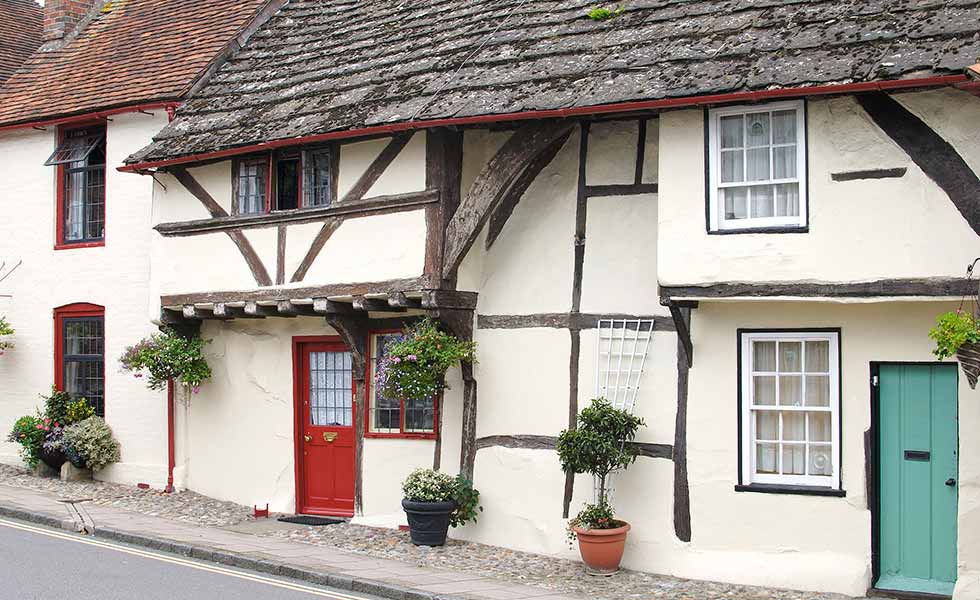What is Limecrete?
Limecrete floors may well be the right option for an old building, but before you go ahead there’s a few things you need to know, says sustainable building expert Tim Pullen

Old buildings allow moisture to be absorbed by the fabric of the building and evaporate away naturally. This is what we call a ‘breathable’ fabric.
Breathability can be important when we consider the floors in old buildings, as they often consist of stone floors laid directly on the earth. In its original situation any moisture below the floor could rise to the floor surface to evaporate away with no detriment.
If we then install a concrete insulated floor with a dampproof membrane (DPM), any moisture below the floor will continue to rise and, as the floor is now impermeable, may get pushed to the walls where it could appear as damp spots. It is this that gives rise to the idea of a breathable floor and where limecrete comes in.
What is Limecrete?
Limecrete is a mix of natural hydraulic lime (NHL5) and sharp sand. Sometimes glass fibres are mixed in to give a more durable surface. Test have shown that physical characteristics in terms of compression strength are more than adequate to meet Building Regulations requirements, and products from companies such as Eco Lime, Tŷ Mawr Lime and The Limecrete Company have Local Authority Building Control (LABC) approval.

Achieving Thermal Efficiency
The density and low thermal conductivity of earth floors mean that they provide good thermal mass. They are capable of absorbing heat and releasing it when the internal temperature drops. When the earth is reasonably dry, the ground under the building will maintain a fairly stable temperature of around 10°C year round. But that is not enough to meet modern standards of thermal efficiency and potential heat loss, so some form of insulation and, perhaps ironically, a moisture barrier, is needed. Standard insulation materials are not breathable, so cannot be used, neither can a traditional DPM.
Recycled Foam Glass as Insulator
The default option is recycled foam glass – small foamed glass beads used as the base to limecrete (rather than hardcore) – that provides both the insulation and the moisture barrier, although a breathable moisture barrier can also be used.
There is another reason why recycled foam glass may be used. Achieving true breathability is always tricky and lime is a more tricky material to work with than cement. It needs mixing in a different way, and needs different laying and curing methods.
Laying limecrete in cold or wet weather conditions can be problematic and the usual hardcore base will also be a problem. Hardcore allows capillary action that could draw up ground moisture. As a breathable floor cannot have a traditional DPM, that moisture could penetrate the limecrete and cause damp problems. There are not many non-capillary substrate materials available, which is why foamed glass beads have become the default option.
What Floor Finishes Can Be Used?
Any breathable floor finishing material will be fine. If stone, slate or tiles are used then the grout gap needs to be a little wider than usual and the adhesive must also be breathable. Wood is the most favourable and presents no problems.
Is Limecrete Essential in All Old Homes?
Limecrete is used because of its ability to deal with naturally occurring moisture. It has nothing to do with air moving in and out of the house. A modern house, built to modern standards, will be able to deal with moisture, without the trouble and expense of breathable construction.
Geocell foam glass is now widely used under concrete construction in new builds, with a separate LABC approved system for this.
When it comes to old properties with stone floors laid directly on the earth, there is an argument that these are breathable floors and if you are replacing them, then there is a need for limecrete. There are two problems with this argument:
- The stone making up the floor may or may not be breathable. Slate, for instance, is not a breathable material and was commonly used as flooring. Any ‘breathing’ (i.e. moisture dispersal) can only be through the joints between the slate slabs. The implication is that if we laid a concrete floor but left sufficient gaps around the edges, that too would be breathable.
- If we have a breathable floor, by implication at least, we will also need breathable wall.
Conclusion
The problem facing people converting old buildings is how to bring them to modern standards of comfort and meet the ever-growing demands for CO2 reduction while retaining the character of the original building.
A limecrete floor, laid on foamed glass, is seen as one way of helping with this problem. It prevents damp penetration, provides insulation, maintains breathability and provides a solid, durable floor, in character with the original building. But it is an expensive option using materials that are tricky to work with, and not necessary as often as might be imagined.
The main reason for installing a limecrete floor is to prevent moisture that may (or may not) rise from the ground being pushed to the walls and causing damp problems.
Get the Homebuilding & Renovating Newsletter
Bring your dream home to life with expert advice, how to guides and design inspiration. Sign up for our newsletter and get two free tickets to a Homebuilding & Renovating Show near you.
Tim is an expert in sustainable building methods and energy efficiency in residential homes and writes on the subject for magazines and national newspapers. He is the author of The Sustainable Building Bible, Simply Sustainable Homes and Anaerobic Digestion - Making Biogas - Making Energy: The Earthscan Expert Guide.
His interest in renewable energy and sustainability was first inspired by visits to the Royal Festival Hall heat pump and the Edmonton heat-from-waste projects. In 1979
this initial burst of enthusiasm lead to him trying (and failing) to build a biogas digester to convert pig manure into fuel, at a Kent oast-house, his first conversion project.
Moving in 2002 to a small-holding in South Wales, providing as it did access to a wider range of natural resources, fanned his enthusiasm for sustainability. He went on to install renewable technology at the property, including biomass boiler and wind turbine.
He formally ran energy efficiency consultancy WeatherWorks and was a speaker and expert at the Homebuilding & Renovating Shows across the country.

